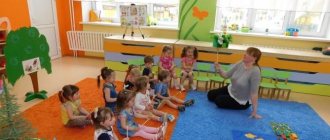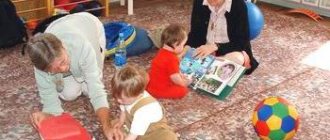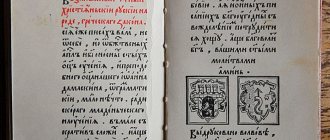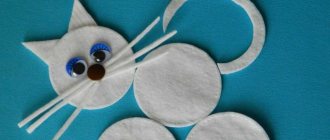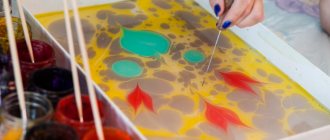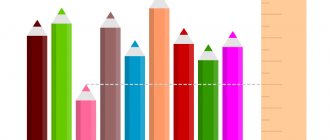Design and research work “Paper: history, properties, types, application and production.”
The technological flow chart for paper production consists of several processes. All stages of papermaking production are carried out on high-performance machines.
1. Preparation of paper pulp (grinding and mixing components, sizing, filling and coloring of paper pulp).
The production of cellulose involves mechanical processing of wood and then chemical reactions with sawdust.
Grinding and mixing.
Coniferous trees are ground into fine sawdust. These sawdust are placed in a boiling solution containing NaHSO4 (sodium hydrogen sulfide) and SO2 (sulfur dioxide). Boiling is carried out at high pressure for many hours. In this case, a chemical reaction occurs in the solution, as a result of which the substance hemicellulose and the substance lignin (a mixture of aromatic hydrocarbons) are obtained, as well as the main reaction product - pure cellulose, which precipitates.
Next, the sediment is crushed using rolls, resulting in cellulose particles of about 1 mm. And when such particles get into water, they immediately swell and form a suspension of cellulose fibers in water - a dark brown pulp. Subsequently, this pulp is bleached.
To make the paper suitable for writing and give it hydrophobic properties, bleached and crushed kaolin, glue, and tint are introduced into the paper pulp and everything is mixed in the required proportions.
Sizing.
The purpose of sizing is to give paper or cardboard
limited absorbent properties in relation to water, ink, printing ink and other liquids and improvement of many other physical and mechanical properties.
Hydrophobic (water-repellent) substances are used for sizing. This can be starch, animal glue, rosin extracted from the resin of coniferous trees, or a special ready-made glue. These substances envelop cellulose fibers, which gives them moisture resistance and mechanical strength.
Filling
is the introduction of mineral filler substances into the paper composition to improve its quality and economic performance. This has the following goals: reducing the cost of paper, increasing its whiteness, increasing the smoothness of the paper surface, reducing opacity, increasing softness and ductility, reducing bulk density, porosity and, consequently, the absorption of printing inks, etc.
One of the oldest fillers is kaolin - an earthy mass similar in composition to clays or talc - a compound from the silicate class. CaCO3 chalk (calcium carbonate) is used as a filler to improve printing properties, to increase the whiteness, smoothness, softness and opacity of paper, which is why such papers are called coated. To increase the wet strength of paper, urea and melamine-formaldehyde resins are added. Titanium dioxide TiO2 is used in the production of coated papers. Zinc oxide ZnO is used as a filler for special types of paper.
Waste paper collection
The collection of waste paper began on October 1, 2022, when I was clearing out the shelves in my room. I collected a whole package of written notebooks, old magazines and other unnecessary paper.
This package seemed very heavy to me. I decided to weigh it, it turned out there was a whole kilogram!
A kilogram of paper had to go to a landfill and rot there, polluting the environment.
I heard that old paper is handed over to collection points, and from there it goes for recycling and the production of new things.
It turned out that in our city they also accept waste paper. So I decided to collect as many kilograms of paper as possible to try to save at least one tree from cutting down, and at the same time, with the money received, buy a seedling and plant it at home.
To save one tree from being cut down, you need to gain 100 kg.
A large box was placed on the veranda, in which various papers were collected: old notebooks, newspapers, tea packaging, cardboard boxes and much more. When the box was full, I put the waste paper in bags and took it out to the barn. Dad and I decided to clear out the attic; there were a lot of old magazines and newspapers there. My grandfather and neighbors helped a little; they also gave away old magazines that they had collected for many years.
Exactly half a year later, on April 1, there was already a lot of paper.
My dad and I went to hand it over. To get all the paper away, I had to go three times, since all of it at once did not fit into the trunk of the car.
Total: 327 kg of waste paper – that’s 3 trees saved from being cut down.
In addition, for each kilogram of waste paper we were paid three rubles, it turned out 327x3 = 981 rubles.
This money was enough to buy a seedling that was planted in our garden.
Conclusion
I proved that anyone can contribute to saving trees and the environment. In just half a year, they collected enough waste paper to save three trees from being cut down, and they planted a tree in their garden.
By collecting and donating recyclable materials, each of us extends the life of ourselves and our families. After all, by cutting down forests, we harm nature. And this leads to the occurrence of diseases. In the case of recycling waste paper, forests remain intact, and there are simply no harmful substances released into the atmosphere.
To write this work, Internet resources were used.
If you liked the page, share it on social networks:
Summary of educational activities with children 4-5 years old using ICT “Paper and its properties”
author: Selikhova Ekaterina Aleksandrovna
Teacher Kindergarten No. 568 Yekaterinburg
Summary of educational activities with children 4-5 years old using ICT “Paper and its properties”
Direct educational activities with children of the middle group “Paper, its properties and types.”
Goal: to continue to form children’s ideas about the properties and types of paper.
Tasks:
Educational : _
expand children’s understanding of paper production, its different types and properties;
Developing : _ _
replenish children's knowledge about the characteristics of paper, develop analytical thinking, memory, attention, observation. Learn to conduct experiments.
Educational:
to cultivate interest in the properties of the objects around us, curiosity, and respect for natural resources.
Materials and equipment : chest, scissors, ball, paper, cardboard, matches, samples of different types of paper, album sheet, glue, brushes, napkins.
ICT : projector, screen, presentation “How paper appeared”
GCD move
Educator: Guys! Today we have guests. Let's welcome our guests!
Friend on the left, friend on the right
The result is an even circle.
We will all join hands,
and let's smile at each other.
- Guys, today we have an unusual activity, a little bit magical. We will experiment with you. You will find out what we will experiment with by guessing the riddle. I brought this wonderful chest (there are different types of paper in the chest). A riddle will tell us what lies in it:
“It can be a document,
poster, candy wrapper, envelope,
letter, wallpaper, leaflet,
album, book, packaging" (paper)
- That's right guys, it's paper.
“Now it’s simply impossible to imagine life without paper.
-What is paper needed for?
- Remember where paper is used?
- But did people always have paper? (children answer negatively)
Educator: -What do you think people wrote on in ancient times? (On the rocks, on the rocks).
At different times people wrote on different materials. - How many of you know how paper is made?
Educator:
View the presentation.
Slide 1: Title page. Slide 2: Long before the advent of paper... in ancient times, people hollowed out inscriptions on stones and made rock paintings. Slide 3: In ancient Greece they wrote on damp clay tiles and tablets filled with wax, squeezing out letters with a sharp stick. They were inconvenient to carry and store. They were heavy, fragile and easily broken. Slide 4: In ancient Egypt, a plant was found on the banks of the Nile River - papyrus. Its stems were cut into thin strips, smeared with glue, ironed with a wooden smoothing iron, dried in the sun and rolled into a tube. They drew and wrote on papyrus with thin sticks. The length of such a book was 100 steps. Slide 5: Parchment was first made in the state of Pergamum in Asia. It was made from the skins of calves and sheep. Sometimes a book written on parchment was worth more than a house, because it took a herd of calves or sheep to make it. What was she like? The book resembled a chest. Slide 6: In Russia they wrote on birch bark. This is birch bark. At first they wrote letters on it, and then books. What did you write with? They scratched it with a bone or iron writing. Slide 7: The inventor Cai Lun first learned to make paper in China. A sticky mixture of bamboo and water was rolled into a flat sheet and dried in the sun. Slide 8: Nowadays, paper is produced at pulp and paper mills from wood of almost all tree species. The lumberjacks cut down the tree, divided it into parts on a machine, chopped the logs into chips, and boiled them in a solution for a long time. And then all the liquid is squeezed out, ironed with a roller, dried, ironed. This is how a blank sheet of paper comes out for a magazine, book and notebook.
OA process
-Now think and tell me, can it be that all objects and things are made of paper? (children's answers).
— Why do you think they don’t make furniture or sew clothes from paper? (various options for children's answers).
-Houses are built from stone, clothes are made from fabric. Because these materials are durable and reliable.
— Is the paper durable? We will check.
I want to invite you to the workshop where we will conduct experiments with paper. Do you want to visit there? Then close your eyes and say all together: -One, two, three, come into the workshop. (Children enter the workshop, I draw the children’s attention to the plates where the pieces of paper lie).
Experimental part.
Studying the properties of paper.
And now we will find out what kind of paper there is. Pick up the paper that is lying on your tables, touch it.
What can you say about her, what is she like? (Children take turns trying the paper by touch, identifying it by touch and describing its properties).
But we will now find out what properties paper has and for this we will conduct a series of experiments:
1) To begin with, take a sheet of paper and a sheet of cardboard in your hands and try to crumple it? Wrinkles? Twist it? Bend? (twists, bends). (Children's answers).
Conclusion: the thicker the paper, the more difficult it is to fold, curl , and bend .
2) Now tear it up. Is it torn? Sturdy paper?
The paper tears, which means it is fragile.
Conclusion: cardboard is thicker than paper, paper tears easily depending on the thickness.
3) Take scissors and cut first the paper, then the cardboard.
Conclusion: cardboard is thicker than paper. The paper is cut according to ease depending on its thickness.
Do you think it is possible to join the paper? How? (Glue, sew, intertwine).
4) Now put a sheet of paper in a container of water. First dip a napkin into the water, then a landscape piece of paper. What happened?
Conclusion: thin paper gets wet faster and falls apart, thicker paper also gets wet, but it will take longer. Paper is afraid of water, paper is not a durable material.
5) Look, guys, now I’ll set the paper on fire. What happened to her?
Conclusion: the paper burns.
6) Now let's experiment, how does a piece of paper fall?
Raise a piece of paper above your head and release it from your hands. It falls smoothly, swaying in different directions. Tear off a narrow strip from it, lift it above your head and release it. It falls differently: rotating around its axis from top to bottom, i.e., the paper falls in different ways.
Research findings.
- Paper can be thin or thick in structure.
- 2. Paper can be strong or weak.
- Paper is afraid of water.
- Paper can be cut with scissors or torn by hand.
- "The paper is burning"
Game "Magic Paper"
I'll throw the ball to you. Whoever catches it must say what can be made from paper (books, notebooks, boxes, wallpaper, etc.).
And now we’ll tell you what you can do with paper (draw, cut, glue, crumple, tear, etc.).
Final part Well done! Well, it's time to return from the workshop. Let's close our eyes and say the words:
One, two, three, come back to the group. We found ourselves in a group again.
Reflection
Was it interesting in the workshop? What new things have you learned about paper?
Summary of educational activities with children 4-5 years old using ICT “Paper and its properties”


